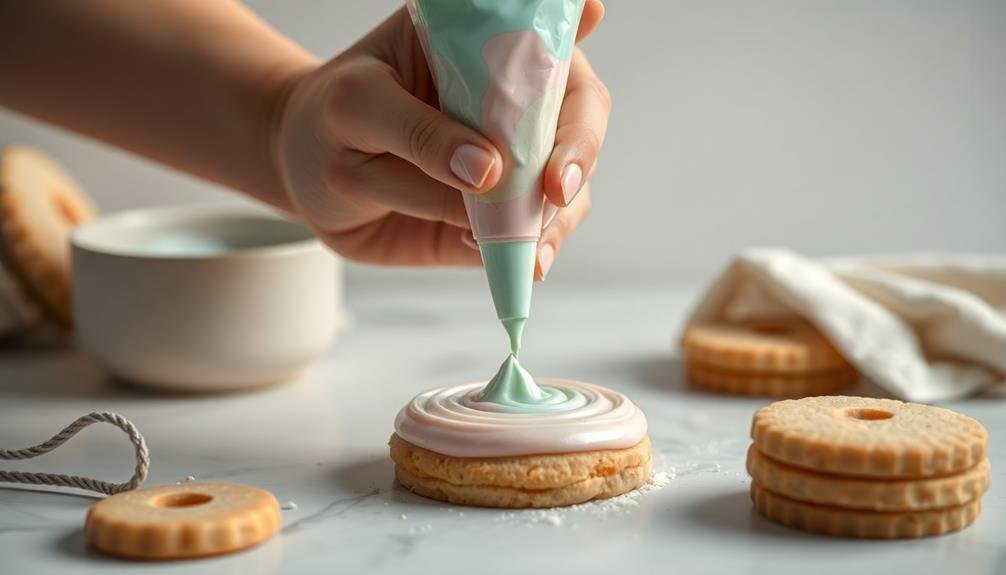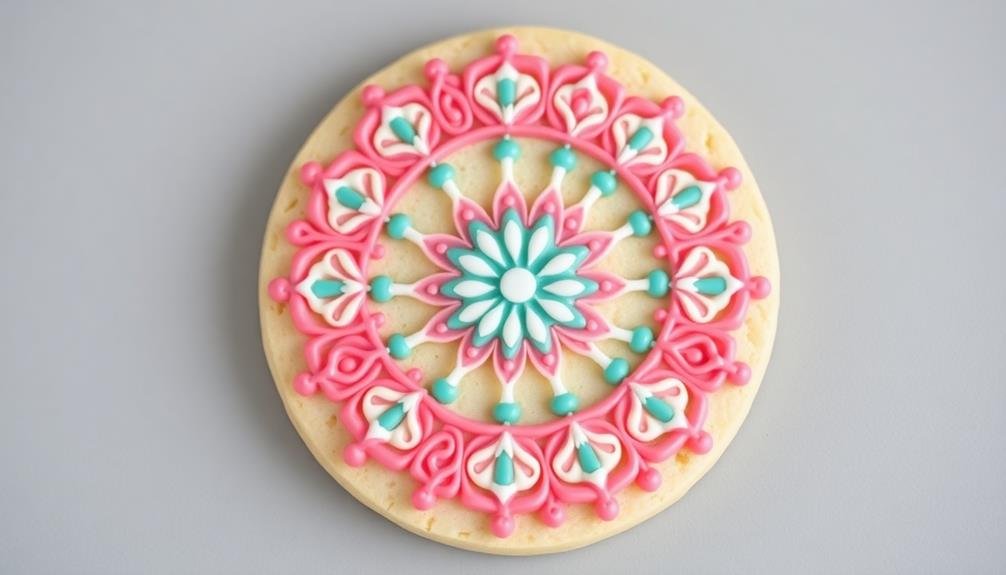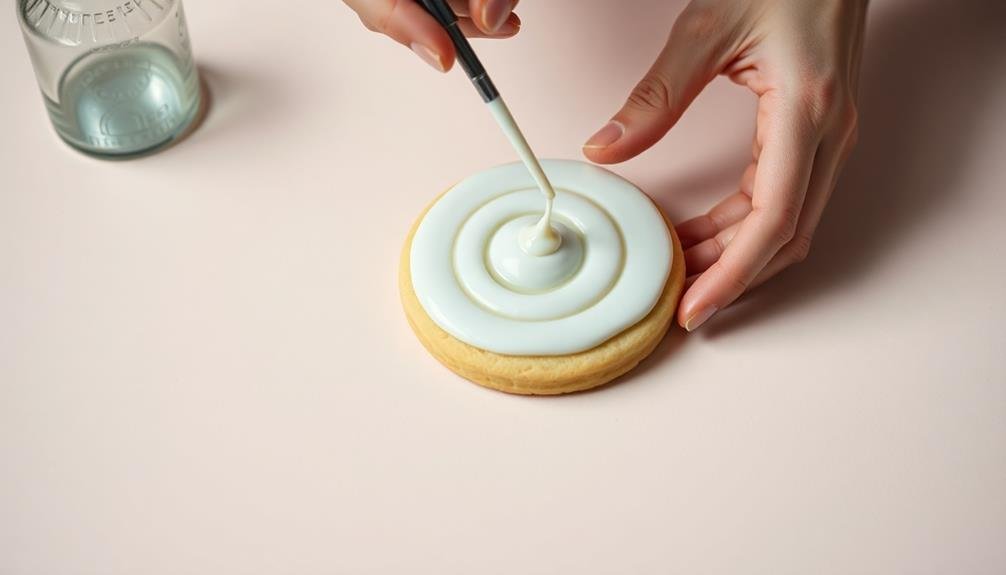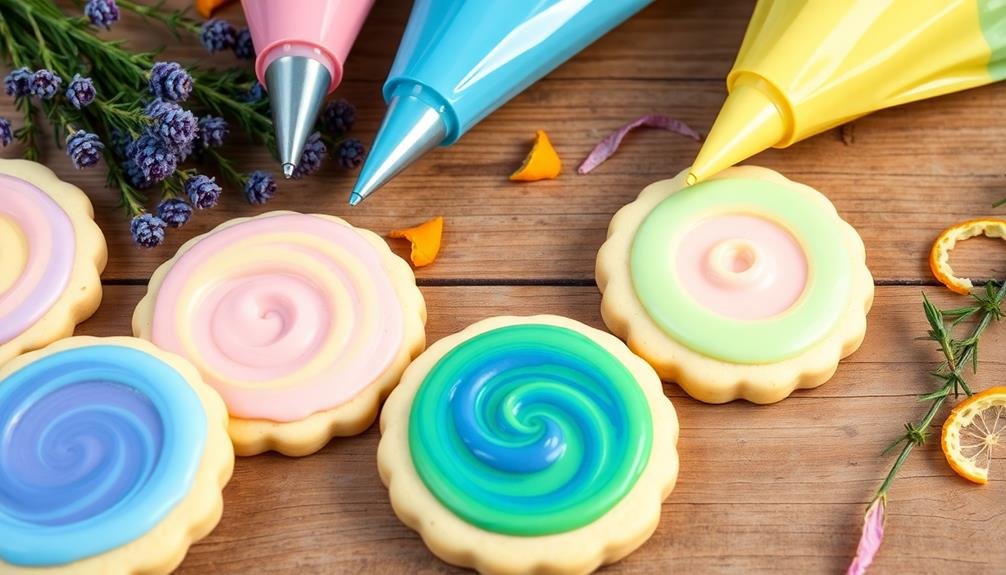Cookie decorating isn't just fun—it's a therapeutic art form that can melt away stress. You can practice mindful icing application, focusing on each stroke to calm your mind. Explore color therapy through frosting, using hues that boost your mood. Create intricate mandala designs for a meditative experience. Let your emotions guide expressive piping techniques. Try zen cookie flooding to enter a state of flow. Engage your senses with tactile texture creation using various tools. Infuse your decorating session with aromatherapy by adding essential oils to your icing. These methods offer a delicious way to unwind and express yourself creatively. Discover how sweet stress relief can be.
Mindful Icing Application

Every stroke of icing on a cookie can be a moment of mindfulness. As you apply the icing, focus on the sensation of the piping bag in your hands and the smooth flow of icing onto the cookie's surface. Be present in the moment, observing the colors and patterns you're creating without judgment.
Start by outlining the cookie's edge with a steady hand, concentrating on maintaining an even line. As you fill in the center, pay attention to how the icing spreads and settles. Notice the subtle changes in texture as it dries.
When adding details, take your time with each element. Whether you're creating intricate designs or simple dots, approach each motion with intention. Breathe slowly and deeply, allowing any tension to melt away with each exhale.
If you make a mistake, don't stress. Instead, view it as an opportunity to practice acceptance and problem-solving. You can often incorporate unintended marks into your design, creating something unique and beautiful.
Color Therapy Through Frosting
Through the use of color in cookie decorating, you can tap into the therapeutic benefits of chromotherapy. Each color you choose for your frosting can evoke specific emotions and promote healing. As you mix and apply different hues, you're actively engaging in a form of color therapy that can positively impact your mood and well-being.
Start by selecting colors that resonate with your current emotional state or the feelings you want to cultivate. Warm colors like red, orange, and yellow can energize and uplift, while cool tones such as blue, green, and purple tend to calm and soothe.
As you frost your cookies, focus on the sensations each color brings. You might find that working with vibrant yellows boosts your optimism, or that serene blues help reduce anxiety.
Experiment with color combinations to create balance in your designs. This process encourages mindfulness as you consider how different shades interact and complement each other.
Don't be afraid to step out of your comfort zone and try unexpected color pairings. The act of exploring and creating with color can be a powerful tool for self-expression and emotional release, making your cookie decorating session a truly therapeutic experience.
Mandala Cookie Design

Mandala-inspired cookie designs offer a powerful avenue for mindfulness and self-expression. As you create intricate patterns on circular cookies, you'll find yourself entering a meditative state, focusing solely on the present moment. This practice can greatly reduce stress and anxiety while promoting relaxation and inner peace.
To begin, select a circular cookie as your canvas and outline the basic structure of your mandala. Start from the center and work your way outward, adding layers of detail as you go. You'll find that the repetitive nature of creating symmetrical patterns can be incredibly soothing.
Here's a guide to help you get started with mandala cookie designs:
| Layer | Design Element | Color Suggestions | Piping Tip | Technique |
|---|---|---|---|---|
| 1 | Center | Gold or White | Round #2 | Dot or Star |
| 2 | Inner Circle | Pastel Colors | Round #3 | Scallops |
| 3 | Middle Ring | Contrasting Hues | Star #16 | Rosettes |
| 4 | Outer Ring | Bold Colors | Leaf #352 | Petals |
| 5 | Border | Neutral Tone | Round #1 | Dots or Lines |
As you work on your mandala cookie, allow your creativity to flow freely. Don't worry about perfection; instead, focus on the process and the calming effect it has on your mind.
Expressive Piping Techniques
Embrace the freedom of expression with freeform swirls and patterns as you pipe icing onto your cookies.
Let your emotions guide your hand, creating unique designs that reflect your inner state.
Choose colors that resonate with your current mood, allowing the decorating process to become a form of visual journaling.
Freeform Swirls and Patterns
Freeform swirls and patterns offer a liberating approach to cookie decorating that encourages self-expression and mindfulness. As you pipe icing onto your cookie canvas, let your creativity flow freely without the constraints of predefined designs. This technique allows you to focus on the present moment, releasing stress and anxiety through fluid movements.
To begin, choose a color palette that resonates with your current mood. Load your piping bag with your preferred icing consistency and start by creating simple swirls or loops. As you gain confidence, experiment with more complex patterns, layering different colors and textures.
| Technique | Description | Mood Effect | Difficulty |
|---|---|---|---|
| Spirals | Circular, outward motion | Calming | Easy |
| Zigzags | Sharp, back-and-forth lines | Energizing | Medium |
| Dots | Various sized round shapes | Playful | Easy |
| Waves | Flowing, undulating lines | Relaxing | Medium |
Emotion-Based Color Choices
Through expressive piping techniques, you can harness the power of color to convey emotions and enhance the therapeutic benefits of cookie decorating. Start by selecting colors that resonate with your current mood or the emotions you want to explore. Warm colors like red, orange, and yellow can evoke feelings of excitement, energy, and joy.
Cool colors such as blue, green, and purple often promote calmness, serenity, and relaxation. As you pipe, focus on how each color makes you feel. Let your emotions guide your hand movements, creating patterns and designs that reflect your inner state.
Don't worry about perfection; instead, embrace the process as a form of emotional expression. You might find yourself using bold, vibrant colors when feeling energetic, or softer, pastel shades when seeking tranquility.
Experiment with color blending to create nuanced emotional representations. Mix complementary colors to express complex feelings or gradients to show emotional shifts. As you work, pay attention to how your mood shifts and evolves.
This mindful approach to color selection and application can help you process emotions and reduce stress while creating beautiful, personalized cookies.
Zen Cookie Flooding

Zen Cookie Flooding offers a meditative approach to cookie decorating that's both calming and creative. This technique involves gently covering the entire cookie surface with a smooth layer of icing, allowing your mind to focus solely on the flowing motion.
To begin, prepare a royal icing with a slightly runny consistency. Hold your piping bag at a 45-degree angle and start at the cookie's edge. Apply steady pressure as you move the tip in a circular motion, gradually working your way to the center. Watch as the icing spreads and settles, filling in gaps and creating a glossy finish.
As you flood each cookie, concentrate on your breathing and the rhythmic movement of your hand. Let go of intrusive thoughts and immerse yourself in the present moment. The repetitive nature of this process can induce a state of flow, reducing stress and anxiety.
Once you've flooded all your cookies, take a moment to admire the clean, uniform surfaces. You can leave them as is for a minimalist look or use them as a blank canvas for further decorations.
Tactile Texture Creation
Explore the soothing world of tactile texture creation in cookie decorating.
You'll find satisfaction in embossing your cookies with textured tools, creating intricate patterns that engage your sense of touch.
Embossing With Textured Tools
Embossing with textured tools offers a unique way to create tactile patterns on your cookies. This technique allows you to imprint intricate designs onto the cookie's surface, adding depth and visual interest.
You'll need specialized embossing tools, such as textured rolling pins, stamps, or mats, which come in various patterns and materials.
To emboss your cookies, start by rolling out your dough to an even thickness. Lightly dust your textured tool with flour to prevent sticking, then firmly press it onto the dough's surface. Roll or press evenly to create a consistent impression.
If you're using a mat, place it on top of the dough and use a regular rolling pin to apply pressure.
For best results, chill the embossed dough before cutting and baking. This helps maintain the crisp lines of your design.
You can enhance the embossed pattern by dusting it with edible powders or painting it with food coloring. Experiment with different tool materials like silicone, wood, or acrylic to achieve various effects.
Don't be afraid to combine multiple textures on a single cookie for a more complex design.
Layering Different Icing Consistencies
Explore the art of layering different icing consistencies to create tactile textures on your cookies. This technique allows you to add depth and interest to your designs, engaging your senses and promoting mindfulness.
Start with a base layer of stiff consistency royal icing, which provides a stable foundation for your design. Once it's dry, apply a layer of medium consistency icing to create raised patterns or borders.
For more intricate details, use flood consistency icing to fill in areas or create smooth surfaces. As you work with these varying consistencies, focus on the feel of the piping bag in your hands and the gentle pressure needed to control the flow.
Experiment with different piping tips to achieve various textures, such as stars, rosettes, or ruffles. You can also use a spatula or brush to create unique patterns in the wet icing.
Don't be afraid to mix and match consistencies within a single design. The contrast between smooth and textured areas adds visual interest and invites touch.
As you layer and blend these different icing textures, you'll find yourself fully immersed in the creative process, letting go of stress and anxiety.
Aromatherapy-Infused Cookie Decorating

Through the power of scent, aromatherapy-infused cookie decorating elevates the therapeutic benefits of this creative activity. You'll enhance your decorating experience by incorporating essential oils into your icing or cookie dough. Lavender, for instance, can promote relaxation, while citrus scents like lemon or orange can boost your mood and energy.
To infuse your icing, add a few drops of food-grade essential oil to your mix. Be cautious with the amount, as these oils are potent. For cookie dough, you can add the oils directly or use dried herbs and spices that naturally contain aromatic compounds.
As you decorate, you'll breathe in these calming or invigorating scents, further reducing stress and improving your overall well-being.
Consider matching scents to your cookie designs. Peppermint-infused snowflake cookies or vanilla-scented flower shapes can create a cohesive sensory experience.
Remember that some essential oils may alter the taste of your cookies, so choose complementary flavors. By engaging multiple senses – touch, sight, smell, and taste – you're creating a more immersive and therapeutic decorating session that can greatly enhance your stress relief and enjoyment.
Frequently Asked Questions
How Long Does a Therapeutic Cookie Decorating Session Typically Last?
You'll typically spend 60 to 90 minutes decorating cookies in a therapeutic session. It's flexible, though, and you can adjust the time based on your needs and schedule. Some people find shorter sessions just as beneficial.
Can Children Participate in Therapeutic Cookie Decorating Activities?
Yes, children can definitely participate in cookie decorating activities. You'll find it's a fun, creative outlet for kids of all ages. They'll enjoy mixing colors, designing patterns, and expressing themselves through edible art. It's a great family activity!
Are There Specific Types of Cookies Best Suited for Therapeutic Decorating?
You'll find sugar cookies ideal for therapeutic decorating. They're flat, sturdy, and provide a blank canvas. Shortbread and gingerbread cookies also work well. Choose cookies that hold their shape and have a smooth surface for easy decorating.
What Supplies Are Needed to Start Therapeutic Cookie Decorating at Home?
You'll need sugar cookies, royal icing, food coloring, piping bags, tips, and a turntable. Don't forget toothpicks, offset spatulas, and a cooling rack. Get creative with sprinkles, edible glitter, and stencils for added flair.
Is It Safe to Eat Cookies Decorated Using Therapeutic Techniques?
You can safely eat cookies decorated with therapeutic techniques. They're no different from regular decorated cookies. Just guarantee you've used food-safe ingredients and followed proper hygiene practices. Enjoy your creations without worry!
In Summary
You've now explored seven therapeutic cookie decorating methods to help you relieve stress. By incorporating mindfulness, color therapy, mandala designs, expressive piping, zen flooding, texture creation, and aromatherapy into your cookie decorating routine, you're not just creating beautiful treats – you're nurturing your mental well-being. Remember, it's not about perfection; it's about the process. So grab your piping bag, let your creativity flow, and watch your stress melt away like buttercream in the sun.





Leave a Reply